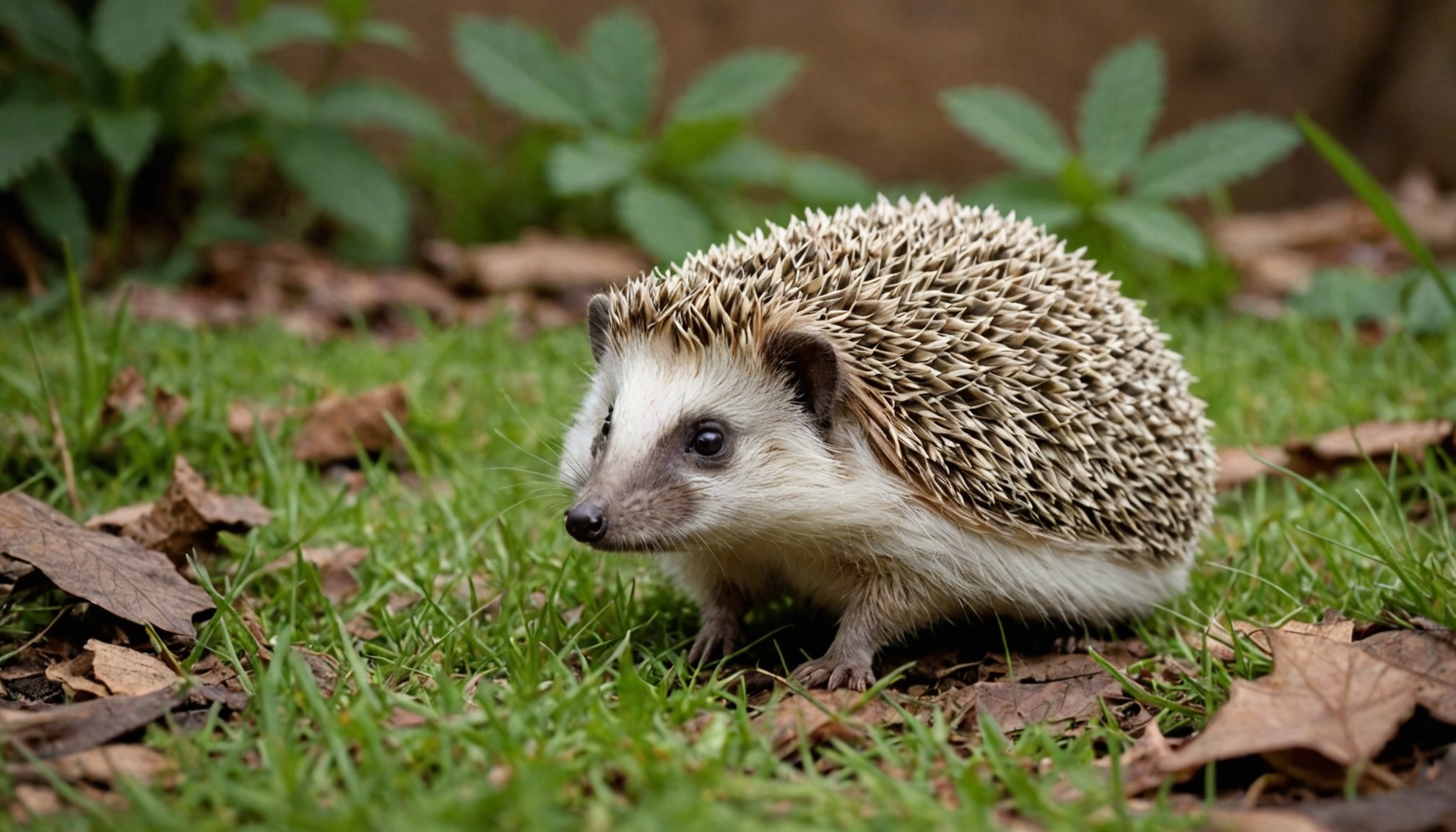Understanding Hedgehog Habitat Needs
Creating a hedgehog habitat that ensures comfort and security is crucial for these creatures. A cozy environment is not just a nicety; it’s a necessity that mimics the hedgehog’s natural conditions.
For a habitat to be effective, it should replicate wild surroundings. Ensuring a space that offers opportunities for hiding and burrowing is beneficial, reflecting a hedgehog’s innate behaviors and requirements. Shelters or small hideaways crafted from safe materials can enhance the habitat’s coziness, providing an ideal environment for rest.
Size and shape are essential considerations when setting up a hedgehog habitat. A roomy enclosure allows ample room for exercise, which is vital for their health. An enclosure that is around 2-4 square feet in area is typically suitable, but bigger is often better. The shape should facilitate exploratory behavior, with no sharp corners that might restrict movement or cause stress.
In addition to the physical space, other components like proper bedding and climate control are vital. However, these are secondary considerations when first establishing the basic habitat structure to ensure the hedgehog feels safe and secure in its home. Understanding these basics will guide you in creating the most comfortable environment possible for your hedgehog.
Also read : How to Design a Roomy Sanctuary for Your Booming Maine Coon Kitten: Top Tips Revealed
Material Selection for Comfort and Safety
When crafting a cozy hedgehog habitat, choosing safe materials is paramount to ensure their well-being. Natural bedding materials such as aspen shavings can provide warmth and comfort, and are often preferred because they are less likely to cause respiratory issues. It is vital to avoid cedar shavings, as their aromatic oils can be harmful to hedgehogs.
Another option is fleece liners, which are not only soft but also washable, offering a sustainable bedding solution. These materials help maintain a clean environment by preventing the accumulation of harmful bacteria.
When considering substrates, there are several pros and cons to evaluate:
- Aspen Shavings: Affordable and absorbent, though can be tracked around.
- Fleece Liners: Reusable and clean, but initial investment is higher.
- Paper-based Bedding: Highly absorbent, with potential for dust irritation.
Careful selection of materials that mimic the hedgehog’s natural conditions will not only create a safe space but also contribute to a cozy environment that reflects their wild habitat. Proper material choices will enhance the hedgehog’s comfort, reduce stress, and foster a healthier living space. Regularly checking the habitat for cleanliness ensures a lasting, safe haven for your hedgehog.
Temperature and Climate Control
For hedgehogs, maintaining a specific temperature range is vital for their health and comfort. These creatures prefer a cozy environment with temperatures between 22°C and 27°C (72°F and 80°F). If the temperature falls outside this range, their ability to thermoregulate might be compromised, potentially leading to hibernation—a dangerous scenario for domesticated hedgehogs.
Thermoregulation can be efficiently managed through simple methods. Heating pads designed specifically for small animals are an excellent choice. They ensure a stable warmth level without overheating. However, always use them under supervision and avoid direct contact with the hedgehog to prevent burns.
Heat lamps can also support temperature regulation. Place them strategically in the enclosure to create a warm zone and allow the hedgehog to choose its preferred spot. Always ensure the lamp is securely in place to avoid accidents.
Equally important is monitoring humidity levels, which should ideally stay around 40-60%. Excessive moisture can lead to respiratory issues, while dry air might cause skin problems. Invest in a reliable thermometer and hygrometer to regularly check these conditions, ensuring the habitat remains safe and comfortable for your hedgehog. Regular monitoring fosters a healthy and thriving environment.
Providing Enrichment and Stimulation
Creating an engaging enrichment environment is vital for hedgehogs to promote mental and physical health. Just like humans, hedgehogs require some fun and excitement in their lives to remain happy and stimulated.
Incorporating a range of playtime activities can help maintain their curiosity and energy levels. Simple actions like scavenger hunts where you hide treats around their enclosure can provide exercise and mental challenges, keeping them on their tiny toes!
When introducing toys and items, ensure they are safe and appropriate for hedgehogs. Small balls, tunnels, or chew toys made from pet-safe materials can offer hours of enjoyment. A small wheel is another excellent addition, encouraging frequent exercise and helping prevent obesity.
It is important to rotate activities and introduce new elements regularly. This practice ensures that hedgehogs do not grow accustomed to their environment, which can result in boredom or stress. New experiences can help maintain their interest and motivate natural behaviors such as foraging and exploring.
Prioritising these enrichment activities creates a healthy outlet for your hedgehog’s energy and increases their overall well-being. By combining practicality with thoughtful design, you can cultivate a habitat that supports an active and joyful lifestyle.
Safety Considerations in Habitat Design
When crafting a hedgehog habitat, addressing safety concerns is of utmost importance. Identifying potential hazardous elements within their living environment will prevent injuries and ensure your hedgehog’s safety. Sharp edges, loose materials, and small objects that can be ingested should be avoided at all costs.
It’s crucial to implement safety measures. For instance, ensuring all wires or cords are out of reach helps negate the risk of chewing, and securely attaching fixtures prevents accidental falls. Additionally, any climbing apparatus should have stable bases to avoid tipping over. Regular inspections of the habitat for wear and tear can catch potential dangers early.
Routine check-ups and maintenance are necessary to guarantee ongoing safety. By doing so, you can promptly address any issues that arise, such as replacing worn bedding or fixing loose fixtures. Moreover, using safe materials not only benefits the hedgehog’s health but extends the longevity of the habitat’s components.
By prioritizing these habitat safety measures, you’ll create a secure and nurturing environment for your hedgehog. Focusing on safety with deliberate planning ensures peace of mind, knowing your hedgehog is shielded from preventable harm while living comfortably in its abode.
Visual Design and Aesthetic Appeal
When fashioning a hedgehog habitat, incorporating aesthetic appeal can enhance both the hedgehog’s and the owner’s experience. A visually pleasing environment does not have to compromise the hedgehog’s comfort or safety. Instead, it can coexist with function seamlessly.
To strike a balance between aesthetics and functionality, consider designs that complement your interior space. Use natural elements that harmonise with the hedgehog’s environment, such as stones, branches, or softly coloured substrates that imitate their natural surroundings.
Creating a themed habitat can add a touch of whimsy while ensuring it remains a cozy environment. For instance, a woodland theme with non-toxic plants or replicas can boost the visual charm while keeping the area safe. Remember, however, to maintain elements that are easy to clean and do not harbor bacteria.
When incorporating design tips, focus on items that serve dual purposes: aesthetically pleasing yet functional. For example, a decorative yet safe bridge can double as a climbing structure. By prioritising ease of cleaning, non-toxicity, and functionality, your hedgehog’s home can be both beautiful and practical. This approach ensures the habitat remains lively, comfortable, and free from visual clutter.



